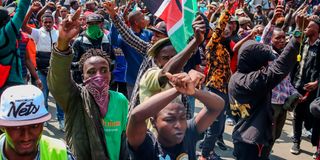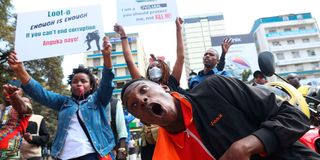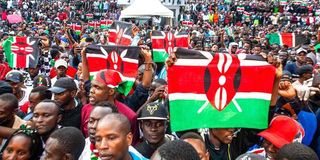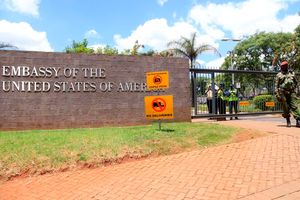
Anti-government protesters march along Moi Avenue in Nairobi on July 23, 2024.
In Kenya, elections often feel less like a hopeful pursuit of good governance and more like an urgent punishment to the incumbent regime. Many citizens, especially the youth, find themselves voting not because they believe in a candidate, but to punish a certain one. Kenyans know how to vote out, but they rarely know why they vote in. It’s a kind of political hostage situation, where the menu remains unchanged and the appetite for real change grows weaker.
This frustration came to a head in 2024, when GenZ-led protests rocked the country. Young people, frustrated with government excesses, corruption, and indifference, took to the streets in a decentralised but incredibly coordinated wave of demonstrations. There were no official leaders, yet the movement had direction. There was no singular face, yet there was unity. The country had never seen anything like it and the political elite were clearly caught off guard.
As 2027 draws closer, a new kind of tension is emerging: the fear of being leaderless in a moment that requires strategy. The question being whispered across WhatsApp groups and university halls is simple: “Now what?” The appetite for a different kind of politics is there. Thousands of youth want to run for office. But very few want to do so through the usual suspects: UDA, ODM, Jubilee, or Wiper. These parties offer nothing new. In fact, they actively repel the very demographic they claim to represent.
Political menu
But here’s the problem: while the desire to run is strong, the infrastructure to support it is weak. Everyone’s looking at the political menu, unimpressed but unsure how to cook something new. How do you start a party from scratch? How do you stay independent without being irrelevant? And how do you turn protest into policy?

Anti-government protesters display placards along Moi Avenue in Nairobi on July 23, 2024.
Kenya’s GenZ isn’t unique in this predicament. In 2024, Bangladesh witnessed a political shift that offers key lessons. After massive protests led by university students over a controversial civil service quota system, Prime Minister Sheikh Hasina resigned and fled the country. What followed wasn’t just celebration, it was organisation. Student leaders, recognising the vacuum in political credibility, launched the National Citizen Party (NCP) in early 2025. It was spearheaded by Nahid Islam, a former student activist, and backed by a broad coalition of young professionals, academics, and working-class citizens. The youth had time and space to organise.
Reimagined politics
The NCP didn’t try to replicate the old system with younger faces. Instead, they reimagined politics. Their Constitution banned dynastic succession. Party financing was crowdsourced and transparent. And unlike traditional parties, they used digital platforms not just for marketing, but for decision-making. Party members could vote on key policies online, in real time.
It was messy at first. Leadership disagreements emerged. Internal debates dragged on. But they stayed the course. Today, NCP is polling as the most trusted party among Bangladeshis under 40.
Kenya’s youth can learn from this playbook. Forming a party is not about rushing to elections - it’s about building an institution. Many young Kenyans today want to run for office but dread being forced to join corrupt parties just to access resources or ballot space. The solution isn’t to join a broken house, it’s to build another one.
But for that to work, consolidation is key. Right now, GenZ is a loud but scattered force. There are grassroots mobilisers, civil society organisers, young lawyers, former protesters, artists, community workers - all willing to contribute but unsure how to connect. Everyone is building something in isolation. The time has come to pool resources, talents, and platforms.

Participants during the Shujaaz Memorial concert held on July 7, 2024 at Uhuru Park in Nairobi.
A shared political home doesn’t have to mean ideological uniformity. It can be a federation of independent-minded groups that agree on core principles: anti-corruption, transparency, people-centred development, and justice. Think of it less as a traditional party, and more like a political cooperative.
Not every success story comes from complete reinvention. Zimbabwe, facing similar youth marginalisation, took a different approach. After years of youth exclusion, the country introduced a 10-seat quota in parliament reserved for candidates aged 21 to 35. Today, Zimbabwe’s parliament has a growing Youth Caucus, and efforts are underway to expand youth representation in local government. It’s not perfect. But it shows that gains can be made tactically, even within existing systems.
Kenya, too, has youth quotas in place, but they’re poorly implemented and often captured by political dynasties placing younger relatives into “youth” seats. A consolidated youth front could lobby for reforms that ensure actual youth participation, not tokenism.
Kenya’s youth don’t need to wait for permission to lead. They already are. What’s needed now is structure, coordination, and the courage to build something that will last beyond a single election cycle. 2027 is coming fast. But the work to change Kenya doesn’t start in campaign season. It starts now and it goes beyond 2027.










